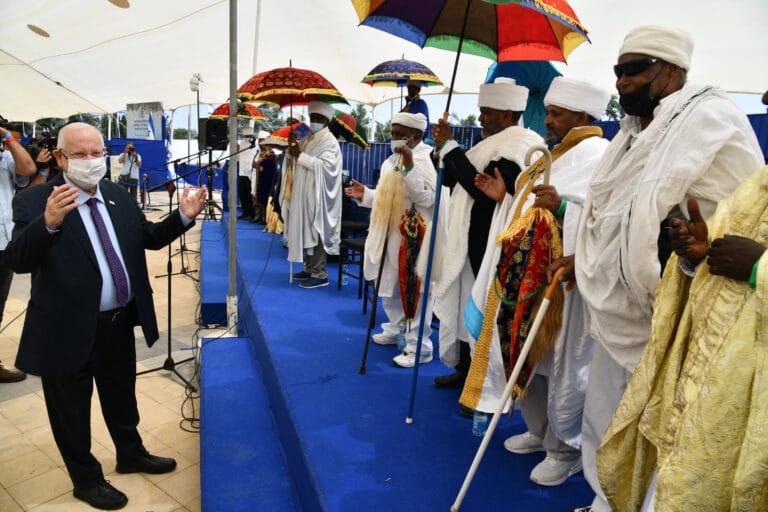
We’re Curious…
This coming week, the Ethiopian Jewish community will celebrate Sigd, an ancient holiday that is observed 50 days after Yom Kippur. “Sigd” means “prostration” in Ge’ez, an ancient Ethiopian liturgical language, and is related to the Aramaic word “sged” (“to prostrate oneself”). Historically, on Sigd, Jews living in Ethiopia would mark the renewal of the covenant between God and the Jewish people and pray to return to Jerusalem.
Now that a majority of Ethiopian Jews live in Israel, the community marks this holiday by gathering at the Western Wall, celebrating the return to their ancestral homeland, and educating all Israelis about Ethiopian Jewish history and culture. Avi Wogderas Wassa, an Ethiopian-Israeli musician, explained that Sigd is a day to “stop and [celebrate] a dream that has come true. [Our] ancestors prayed for generations for our return to Jerusalem and we have fulfilled this dream.”
The State of Israel recognized Sigd as a national holiday in 2008. Today in Israel, it is celebrated for the entire month prior to the 29th of Cheshvan, as a time to explore the rich Jewish heritage of Ethiopia. What is the story of the Ethiopian Jewish community, and what has their experience of integrating into Israeli society been like? And what can the entire Jewish community learn from their experience?
Operations Moses and Solomon
The Jewish community of Ethiopia — also known as the Beta Israel — lived in complete isolation from the rest of the Jewish world for more than 2,000 years. In the 1970s and early 1980s, a civil war and widespread famine in Ethiopia led to the deaths of thousands and an increase in the persecution they already faced. Ultimately hoping to move to Israel, 12,000 Ethiopian Jews trekked by foot through the country’s desert to Sudan. One-third of them died along the way from malnutrition, disease or violence. Upon reaching Sudan, they were prevented from proceeding to Israel and placed in refugee camps where they faced antisemitic persecution.
At this time, Israel had been sending Mossad agents to coordinate small airlifts of Ethiopian Jews to Israel. In 1984, Israel initiated a large-scale rescue mission called Operation Moses, which brought 8,000 Ethiopian Jews from Sudan to Israel in just seven weeks. The Jewish State carried out the operation in secret. Unfortunately, Operation Moses ended prematurely when Sudan’s Arab allies found out about the airlift and pressured Sudan to cut off the operation.
Thousands of Ethiopian Jews remained in war-torn Ethiopia, waiting for the day that they would be able to join their brothers and sisters in Israel. In 1991, a regime change in Ethiopia provided the necessary opening for the Israeli government to act. In May 1991, another airlift, called Operation Solomon, brought more than 14,000 Beta Israel to Israel in just 36 hours.
Today, more than 125,000 Ethiopian Jews live in Israel, with 100 to 300 Ethiopian immigrants arriving in Israel each month. However, thousands of people known as Falash Mura — Jews whose ancestors converted, under duress, to Christianity — remain in Ethiopia. In October 2020, the Israeli government approved the aliyah of 2,000 Falash Mura, a term that some of them consider demeaning. About 8,000 members of this community are currently waiting to emigrate to Israel. More than half of them have immediate family in the Jewish State. Watch our video about the Ethiopian Jewish community to learn more.
Challenges in Transitioning To Life in Israel
After the success of Israel’s daring missions to bring the Ethiopian Jewish community to Israel, the community’s transition into Israeli life was more complicated.
In preparation for the absorption of tens of thousands of Ethiopian Jews, the Israeli government developed an elaborate program covering issues of housing, education and employment. However, this approach did not sufficiently account for social and cultural differences between the existing Israeli population and incoming Ethiopian immigrants. Unlike European immigrants, Ethiopians were coming from rural villages and were not prepared to work and live in a modern, industrialized society. This resulted in social and economic marginalization of the Ethiopian immigrant community.
Making matters worse, not all Israelis supported the aliyah of the Ethiopian Jewish community. In 1980, Yehuda Dominitz, then Director General of the Jewish Agency’s Department of Immigration and Absorption, declared that “[taking] a Falasha out of his village, it’s like taking a fish out of water…I’m not in favor of bringing them [to Israel].”
The new Ethiopian immigrants also faced religious challenges. Although their Jewish status was affirmed in 1973 by the Chief Sephardi Rabbi of Israel Ovadia Yosef, many Israelis continued to question whether Ethiopian Jews were really Jewish.
The Ethiopian Jewish community is not alone in having faced challenges in transitioning to modern Israeli life. Learning a new language, leaving behind family and friends and starting a new life in a different culture are challenges shared by many immigrants. Jews from North Africa and other parts of the Middle East, Holocaust survivors, and Soviet Jews have also faced particular obstacles in integrating into Israeli society.
Like many other countries, Israel has important work to do to address these challenges. Still, this does not absolve the Jewish State of its responsibility to improve the situation. Jewish values such as equality and acceptance of others, loving fellow Jews (ahavat Yisrael) and loving the stranger (ahavat ha-ger) should guide the Jewish state as it navigates these issues.
Ethiopian-Israeli Life Today: Successes and Continued Challenges
Although integration into Israeli society has been slow, many aspects of life for Ethiopian-Israelis have improved since the community first arrived in the Jewish State. In May 2020, Pnina Tamano-Shata of the Blue and White party became the first Ethiopian to serve as a minister in the Israeli government. In 2012, Israel appointed the country’s first Ethiopian-born ambassador, Beylanesh Zevadia.
Ethiopian-Israelis have also risen through the ranks of the military in recent years. In December 2018, an Ethiopian-Israeli soldier became the Israeli Air Force’s first pilot of Ethiopian heritage. And in 2016, Dr. Avraham Yitzhak became the first Israeli of Ethiopian heritage to hold the rank of colonel in the IDF.
The Ethiopian music scene has also been attracting greater attention in Israel. In February 2020, the singer Eden Alene became the first Israeli of Ethiopian descent chosen to represent Israel at the Eurovision Song Contest, winning the spot with her performance of “Halo” by Beyonce. The popular Idan Raichel Project — a group led by the singer Idan Raichel which features Ethiopian musicians — has also helped bring Ethiopian music into the Israeli mainstream starting with the release of its popular 2002 album.
Despite this progress, the Ethiopian-Israeli community still wrestles with problems and full integration is far from complete. The Israeli government has worked to improve the quality of housing, reduce unemployment and combat racism in the workplace and at large. However, poverty, a lack of opportunity, police brutality and other forms of discrimination continue to be issues for this community. Organizations such as the Ethiopian National Project, the Israel Association for Ethiopian Jews and Be’chol Lashon work to ensure the full integration of Ethiopian-Israelis into Israeli society and raise awareness about the community. Ethiopian Jewish activists have been calling on the government to bring remaining members of the Falash Mura community in Ethiopia to Israel for decades.
It was in large part due to all of these efforts that the Israeli government recognized Sigd as an official holiday in 2008. The government’s recent approval of large-scale aliyah for the Falash Mura community, still in Ethiopia, is another testament to this work and improving attitudes toward Ethiopians in Israel.
The Bottom Line
Since rescue missions like Operations Moses and Solomon brought Ethiopian Jews to Israel, the community has experienced both successes and challenges in adjusting to Israeli life. In recent years, the community has achieved greater political representation and more senior ranks in the military and has enjoyed success in Israel’s mainstream music scene. At the same time, discrimination and economic and social disparities persist for this community. Sigd is an opportunity to learn and teach about the remarkable story of this community, including their rich history and culture, which, if you’re Jewish, is part of your story as well. Through the story of Ethiopian Jewry, we learn about the diversity within the state of Israel, the work to ensure the full integration of different groups of immigrants and how to make a more equal and inclusive society for all.
Originally Published Nov 9, 2020 11:57AM EST
